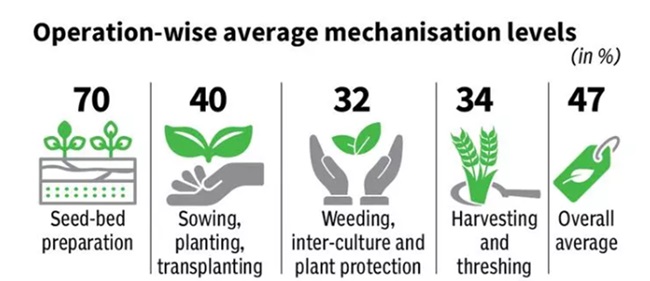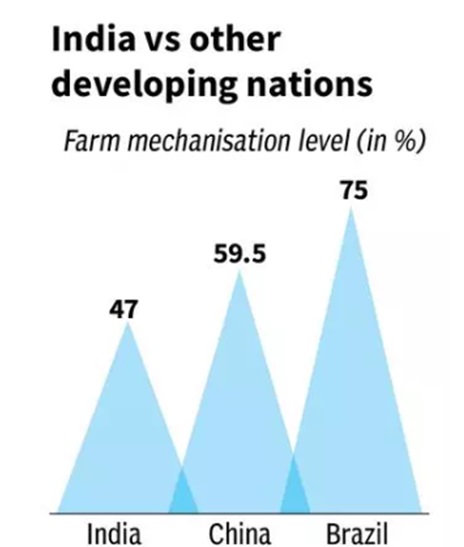|
Mains Exam
(General Studies Paper- : Direct and indirect agricultural assistance; Public distribution system-objectives, functions, limitations, reforms; Buffer stock and food security related issues; Technology Mission)
|
Reference
The Indian agricultural sector, which provides food grains to more than 140 crore people, has still not reached the mark of 50% of total mechanization.
Status of Agricultural Mechanization in India
- The overall average mechanization level for crops like rice, wheat, maize, jowar and bajra, pulses, oilseeds, cotton and sugarcane is 47%.
- The average mechanization level for crops operation-wise is as follows:
- For field preparation: 70%
- For sowing, planting, transplanting: 40%
- For weeding and inter-cultivation: 32%
- For harvesting and threshing: 34%

- Among the crops, only wheat (69%) and rice (53%) have more than 50% mechanisation. The overall level of mechanisation for other crops is as follows:
- Maize (46%)
- Pulses (41%)
- Oilseeds (39%)
- Cotton (36%)
- Sugarcane (35%)
- Jowar and Millets (33%)
India's position compared to other countries
- According to a report of the Standing Committee of Parliament, the country's overall agricultural mechanization level is lower than other developing countries such as China (59.5%) and Brazil (75%).

- The adoption of mechanisation by farmers in different states in India depends on various factors like socio-economic conditions, geographical conditions, crops grown, irrigation facilities etc.
- There is region-wise as well as crop-wise variation in agricultural mechanisation.
Benefits of Agricultural Mechanization in India
- Savings of seeds, pesticides and fertilizers
- Improved seed germination
- Savings of time and water
- Reduced weed levels
- Less labour required
- Increased number of crops grown per year
- Increased crop yield
Challenges
- Small size of agricultural holdings
- High number of marginal and small farmers
- High cost
- Low awareness
- Low technical efficiency
- Geographical conditions
Way forward
- 86% of the farmers in the country have less than 2 hectares of land. Keeping this fact in mind, there is a need to provide suitable machines for small holdings.
- The government launched a sub-mission on agricultural mechanization in the year 2014-15 to promote the inclusive development of agricultural mechanization in the country.
- Under this scheme, state governments are provided assistance for providing training and demonstration of agricultural machinery and assistance to farmers in the purchase of various agricultural machinery and equipment as well as for setting up custom hiring centers.
- Awareness should be spread among farmers to adopt technology. Schemes like Lakhpati Didi are an effective step in this area.
- The problem of size of land holdings can be solved through consolidation of holdings.
- Agricultural mechanization can be promoted by collectively purchasing agricultural inputs and providing subsidy by the government on it.



